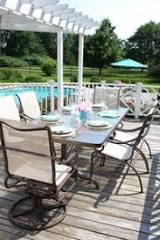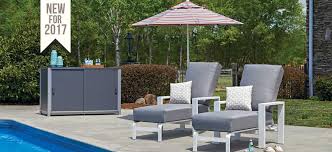Patio Furniture Mesh Material

Most commercial cleaners are too abrasive to be used on resin lawn furniture. But you won’t have to worry about scratching or dulling the surface if you clean your resin furniture with a wet sponge dipped in baking soda. Wipe using circular motions, then rinse well. See more uses for Baking Soda. Is your plastic-mesh lawn furniture looking dingy? Before you place it curbside, try washing it with some mild detergent mixed with 1/2 cup bleach in 1 gallon (3.7 liters) water. Rinse it clean, then air-dry. See more uses for Bleach. If you live in a hot, humid climate, you’re probably no stranger to seeing mildew on your wooden decks and patio furniture. But before you reach for the bleach, try these milder vinegar-based solutions: Keep some full-strength white vinegar in a recycled spray bottle and use it wherever you see any mildew growth. The stain will wipe right off most surfaces, and the vinegar will keep it from coming back for a while. Remove mildew from wood decks and wood patio furniture by sponging them off with a solution of 1 cup ammonia, 1/2 cup white vinegar, and 1/4 cup baking soda mixed in 1 gallon (3.7 liters) water.

Keep an old toothbrush on hand to work the solution into corners and other tight spaces. To deodorize and inhibit mildew growth on outdoor plastic mesh furniture and patio umbrellas, mix 2 cups white vinegar and 2 tablespoons liquid dish soap in a bucket of hot water. Use a soft brush to work it into the grooves of the plastic as well as for scrubbing seat pads and umbrella fabric.
Costa Mesa Moving Company ReviewsRinse with cold water;
45 Adapter T Shirtthen dry in the sun.
Discount Bathroom Vanities Orange County Ca See more uses for Vinegar. Bring color and shine back to faded plastic patio furniture. Simply spray WD-40 directly on the surface and wipe with a clean, dry cloth. You’ll be surprised at the results.

See more uses for WD-40. Get our Read Up newsletter how we use your e-mail We will use your email address to send you the newsletter each week, and we may also send you occasional special offers from Reader's Digest. For more information please read our privacy policy. Enhance any outdoor setting with Windward's sling furniture. Sling combines versatile style with easy cleaning and maintenance, a perfect choice for any outdoor setting. All sling fabric is double stitched for exceptional durability. Select Windward sling collections are also available in padded sling opening up even more design possibilities!Outdoor fabrics are made from a variety of fibers and fiber blends, including polyester, acrylic and cotton. Outdoor fabrics differ from indoor fabrics in that they are made to be more durable, and they undergo a chemical treatment process during manufacturing that ensures they will resist stains and mildew. Outdoor fabrics are woven fibers that differ in strength and durability.

The primary difference between each type of the most commonly used outdoor fabric lies in the manufacturing process and the fibers that they are made from. Solution-Dyed Acrylics Solution-dyed acrylics are fabrics that are dyed before the yarn is created. Most fabrics begin colorless, and then the fibers are woven into yarn, and the yarn is dyed before it is woven into a fabric. With solution-dyed acrylic, a liquid acrylic solution is mixed with the dye, and then it is formed into a fiber so it already has color before it is spun into a yarn. This process makes it color-fast and water-resistant. Solution-dyed acrylics are soft and breathable like canvas and are commonly used in awnings and patio umbrellas, but a softer, more porous version is also used for outdoor pillows and cushions. Acrylic-Coated Polyesters Acrylic is used as a base for many outdoor fabrics because of its durability and resistance to wrinkling, fading, and mildew growth. Polyester shares may of these properties, and the use of both fabrics in one material makes a durable outdoor fabric.

To make acrylic-coated polyester, the fabric threads are woven first and then the material is dipped into an acrylic coating to color it. This fabric is also available in cotton-polyester blends, which typically have a more appealing appearance. Acrylic-coated polyester and cotton-polyester blends are typically used to make boat and car protectors but may also be used as patio umbrellas and awnings. Vinyl-Coated Synthetic Fiber Mesh Vinyl-coated synthetic fiber mesh is also referred to as PVC mesh or slingable fabric. It is often used for sling-type outdoor chairs, whose fabric -- not the frame -- supports your weight. This fabric is strong and does not stretch. Other fabrics, such as solution-dyed acrylic, printed polyester and printed acrylic outdoor fabrics, are not strong enough to cover these types of chairs. Most PVC mesh fabrics are made of vinyl-coated polyester or acrylic yarns, as well as other synthetics such as olefin and PVC, but the composition of materials varies depending on the manufacturer.

They make a durable, easy-to-clean, colorfast and strong outdoor fabric that doesn’t promote mildew growth. Olefin Olefin is a manmade fiber that is typically used along with other fibers to create outdoor fabric blends. It is often used in outdoor furniture and for a variety of other applications, including house wrap, marine coverings and clothing. Depending on its chemical structure, olefin may also be referred to as polyethylene or polypropylene. It is manufactured in a similar manner as polyester and nylon. The chemicals used are melted and fed through a shower-head-like device called a spinneret head to form long fibers. Olefin typically has a smooth texture and is usually solution-dyed. It is a durable fabric that dries quickly and resistant to weathering, chemicals, stains and mildew. Canvas Canvas is a strong, heavy-duty outdoor fabric used to make sails, tents, backpacks, tarps and even canoes. Modern canvas fabrics may be made from a variety of materials but are usually made using cotton or linen.